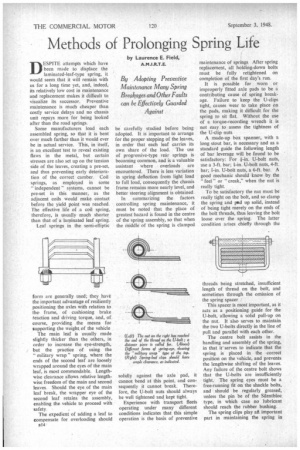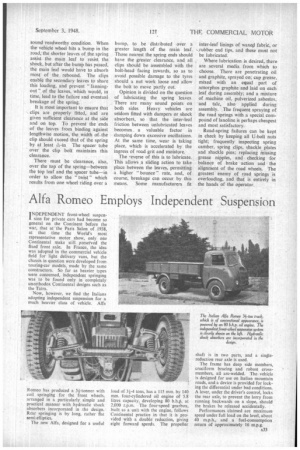Methods of Prolonging Spring Life
Page 48

Page 51

If you've noticed an error in this article please click here to report it so we can fix it.
by Laurence E. Field, A.M.I.R.T.E.
By Adopting Preventive Maintenance Many Spring Breakages and Other Faults can be Effectively Guarded
Against
DESPITE attempts which have been made to displace the laminated-leaf-type spring, it would seem that it will remain with us for a long time yet, and, indeed, its relatively low cost in maintenance and replacement makes it difficult to visualize its successor. Preventive maintenance is much cheaper than costly service delays and no chassis unit repays more for being looked after than the road springs.
Some manufacturers load each assembled spring, so that it is bent over much farther than it would ever be in actual service. This, in itself, is an excellent test to reveal existing flaws in the metal, but certain stresses are also set up on the tension side of the leaves, creating a pre-set, and thus preventing early deterioration of the correct camber. Coil springs, as employed in some " independent" systems, cannot be pre-set in this manner, as the adjacent coils would make contact before the yield point was reached. The effective life of a coil spring, therefore, is usually much shorter than that of a laminated leaf spring.
Leaf springs. in the semi-elliptic
form are generally used; they have the important advantage of resiliently positioning the axles with relation to the frame, of cushioning brake reaction and driving torque, and, of course, providing the means for supporting the weight, of the vehicle
The main leaf is usually made slightly thicker than the others, in order to increase the eye-strength, but the practice of using the " military wrap" spring, where the ends of the second leaf are loosely wrapped around the eyes of the main leaf, is most commendable. Lengthwise clearance allows relative lengthwise freedom of the main and second leaves Should the eye of the main leaf break, the wrapper eye of the second leaf retains the assembly, enabling the vehicle to proceed with safety
The expedient of adding a leaf to compensate for overloading should s14 be carefully studied before being adopted. It is important to arrange for the proper stepping of the leaves, in order that each leaf carries its own share of the load. The use of progressive-type rear springs isbecoming common, and is a valuable assistant where overloads are encountered. There is less variation in spring deflection from light load to full load, consequently the chassis frame remains more nearly level, and better steering alignment is obtained.
In summarizing the factors controlling spring maintenance, it must be noted that the place of greatest hazard is found in the centre of the spring assembly, so that when the middle of the spring is clamped solidly against the axle pad, it cannot bend at this point, and consequently it cannot break. Therefore, the U-bolt nuts should always be well tightened and kept tight.
Experience with transport fleets operating under many different conditions indicates that this simple operation is the basis of preventive maintenance of springs After spring replacement, all holding-down bolts must be fully retightened on completion of the first day's run.
It is possible for worn or improperly fitted axle pads to be a contributing cause of spring breakage. Failure to keep the U-clips tight, causes wear to take place on the pads, making it difficult for the spring to sit flat. Without the use of a torque-recording wrench it is not easy to assess the tightness of the U-clip nuts A made-up box spanner, with a long stout bar, is necessary and as a standard guide the following length of bar leverage will be found to be satisfactory: For f-in. U-bolt nuts, use a 3-ft. bar; i-in. U-bolt nuts, 4-ft.
bar; U-bolt nuts, a 6-ft. bar. A good mechanic should know by the " feel " or "creak," when the nut is really tight.
To be satisfactory the nut must be really tight on the bolt, and so clamp the spring and pad up solid, instead of being tight merely on the ends of the bolt threads, thus leaving the bolt loose over the spring The latter condition arises chiefly through the threads being stretched, insufficient length of thread on the bolt, and sometimes through the omission of the spring spacer This spacer is most important, as it acts as a positioning guide for the U-bolt, allowing a solid pull-up on the nut. It also serves to maintain the two U-bolts directly in the line of pull and parallel with each other.
The centre bolt assists in the handling and assembly of the spring, in that it' serves to indicate that the spring is placed in the correct position on the vehicle, and prevents the lengthwise shifting of the leaves. Any failure of the centre bolt shows that the U-bolts are insufficiently tight. The spring eyes must be a free-running fit on the shackle bolts, and should be regularly greased, unless the pin be of the Silentbloc type, in which case no lubricant should reach the rubber bushing.
The spring clips play aft important part in maintaining the spring in
sound roadworthy condition. When the vehicle wheel hits a bump in the road,'the shorter leaves of the spring assist the main leaf to resist the shock, but after the bump has passed, the main leaf would have to absorb most of the rebound. The clips enable the secondary leaves to share this loading, and prevent " fanningout " of the leaves, which would, in time, lead to the failure and eventual breakage of the spring.
It is most important to ensure that clips are properly fitted, and are given sufficient clearance at the side and on top. To prevent the ends of the leaves from binding against lengthwise motion, the width of. the clip should Exceed that of the spring by at least -fie-in The spacer tube over the clip bolt maintains this clearance.
There must be clearance, also, over the top of the spring—between the top leaf and the spacer tube—in order to allow the " twist " which results from one wheel riding over a bump. to be distributed over a greater length of the main leaf, Those nearest the spring ends should have the greater clearance, and all clips should be assembled with the bolt-head facing inwards, so as to avoid possible damage to the tyres should a nut work loose and allow the bolt to move partly out.
Opinion is divided on the question of lubricating the spring leaves There are many sound points on both sides Heavy vehicles are seldom fitted with dampers or shock absorbers, so that the inter-leaf friction between unlubricated leaves becomes a valuable factor in damping down excessive oscillations. At the same time, wear is taking place, which is accelerated by the ingress of road grit and moisture.
The -everse of this is to lubricate. This allows a sliding action to take place between the leaves, permitting a higher " bounce " rate, and, of course, breakage can occur by this means. Some manufacturers fit
inter-leaf linings of waxecl fabric, or ,..,rubber end tips, and these must not be lubricated.
Where lubrication is desired, there are several media from which to choose. There are penetrating oil and graphite, sprayed on; cup grease, mixed with an equal part of amorphus graphite and laid on each leaf during assembly; and a mixture of machine oil, pulverized asbestos, and talc, also applied during assembly. The frequent spraying of the road springs with a special compound of lanoline is perhaps cheapest and most satisfactory.
Road-spring failures can be kept in check by keeping all U-bolt nuts tight; frequently inspecting spring camber, spring clips, shackle plates and shackle pins; replacing missing grease nipples, and checking for balance of brake action and the alignment of the road wheels. The greatest enemy of road springs is overloading, and that is entirely in the hands of the operator.




















































































